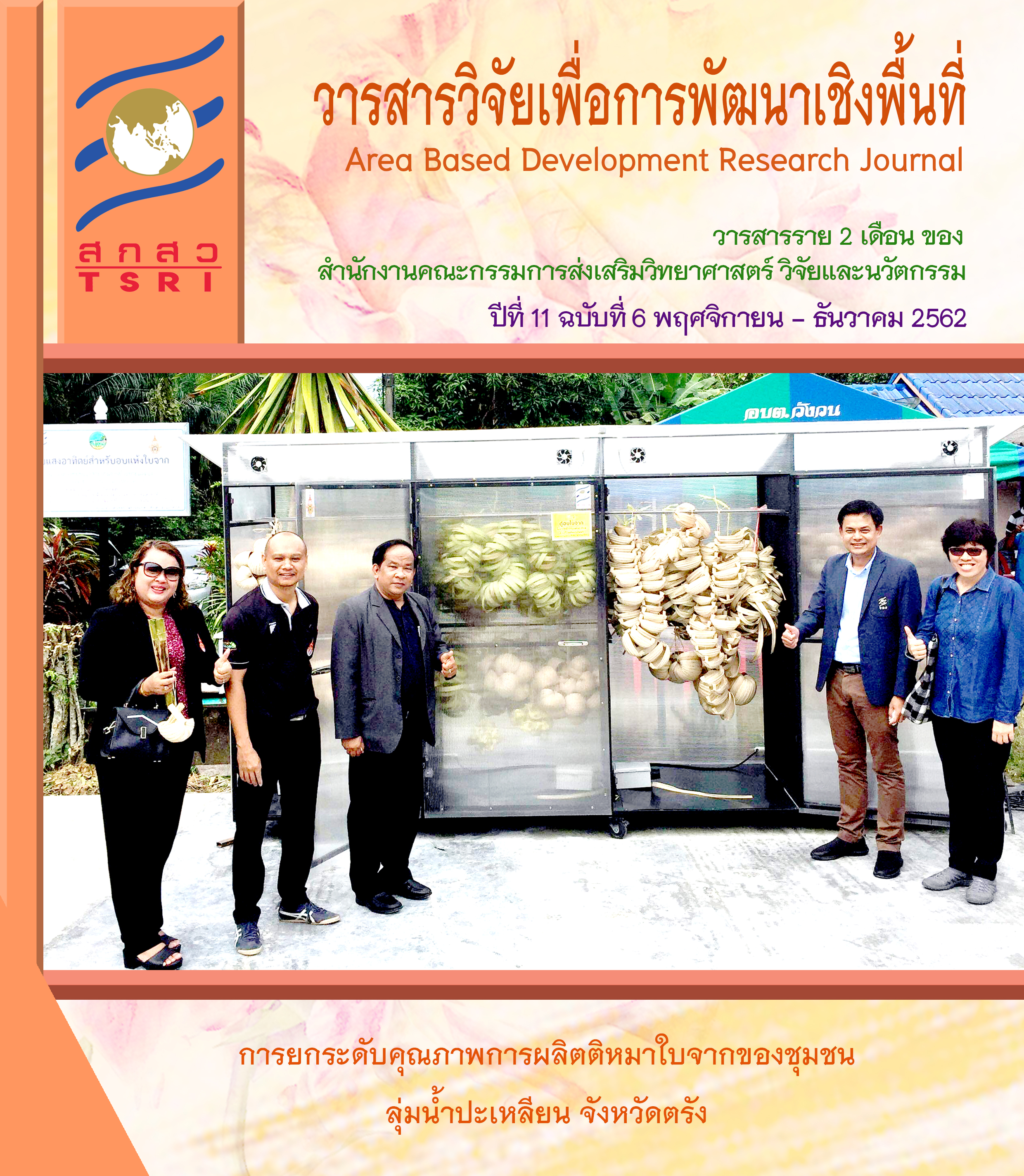By-Product Synergy from Nipa Palm Frond Processing Waste Ban Laem Community, Trang Province
Main Article Content
Abstract
Most people in Palian river basin of Ban Laem community, Kantrang district, Trang province have utilized the local resources of Nipa palm to produce cigarette paper and earned side income. The palm peeling process leaves the waste of the Nipa palm frond and shaft, resulting in disposal problems. Thus, the purpose of this study is to increase the value of the left-behind material from Nipa palm frond by making two new products, namely plant pots and fancy charcoal deodorizer.The research process involves both laboratory work and participatory action research by the community. The steps are as follows: 1) Analysis, synthesis of community data 2) Products development from by-product Nipa palm frond 3) Transferring knowledge and technology to the community. 4) Ban Laem community cluster, and 5) Marketing promotion. The results indicate Ban Laem community’s initial problems of Nipa palm frond waste, especially on visual environment of the communities’ landscapes. The study exploits the Nipa palm frond by-product as material for plant pot production. The experiment has determined the three materials as by-product of Nipa palm frond: soil : pastry glue, at the ratio of 4.0 : 1.0 : 4.0, which is the best optimal mixing ratio for molding. For the production of fancy charcoal deodorizer Nipa palm frond, the experiment sets the ratio of activated charcoal : pastry glue as 0.9:10, which is the best optimal value for molding step, smooth surface, durability, and appropriate humidity, corresponding to standard mark on the community product, licensed for charcoal odour absorber (SCP No. 180/2546). The knowledge and technology transfer to Ban Laem community results in community clustering and founding an enterprise called Palian Community Enterprise Group. The members collaborate to promote the products and extend distribution channels in various forms, such as co-organizing exhibitions with public and private sectors, and publicizing on fan page Facebook channel to raise public interest. The project helps increase the community’s revenues and improve the quality of life.
Article Details

This work is licensed under a Creative Commons Attribution-NonCommercial-NoDerivatives 4.0 International License.
References
เตือนใจ ปิยัง, วรรณวภิา ไชยชาญ และ กัตตินาฏ สกลุสวัสดิพันธ์. (2561).การผลติกระถางต้นไม้ที่เป็นมิตรต่อสิ่งแวดล้อมจากกากตะกอนน้ำมันปาล์มและวัสดุเหลือทิ้งจากการเพาะเห็ด. วารสารวิจัยมหาวิทยาลัยเทคโนโลยีราชมงคลศรีวิชัย, 10(3), 497-511.
ผกามาศ ทองคำ. (2550). โครงการศึกษาและส่งเสริมการผลิตภัณฑ์จากทางจาก. (รายงานวิจัยฉบับสมบูรณ์). สงขลา: มหาวิทยาลัยสงขลานครินทร์.
พงศธร หนูเล็ก, จิราณุวัฒน์ แสงมุกด์ และชินพันธุ์ แซ่ซิ้ม. (2551). กระถางต้นไม้จากขุยมะพร้าวไอเดียลดโลกร้อน.
สืบค้นเมื่อ 8 กรกฏาคม 2561, จาก https://mgronline.com/smes/detail/9510000060064.
สำนักงานมาตรฐานผลิตภัณฑ์อุตสาหกรรม. (2560). มาตรฐานผลิตภัณฑ์ชุมชนถ่านดูดกลิ่น. สืบค้นเมื่อ 11 พฤศจิกายน 2561, จาก https://tcps.tisi.go.th/pub/tcps0180_60(ถ่านดูดกลิ่น).pdf.
สังเวย เสวกวิหารี. (2554). ถ่านดูดกลิ่นผลิตภัณฑ์กำจัดกลิ่นจากเปลือกเมล็ดมะม่วงหิมพานต์. (รายงานวิจัยฉบับสมบูรณ์). กรุงเทพฯ: มหาวิทยาลัยเทคโนโลยีราชมงคลพระนคร.
อดิศร ไกรนรา. (2554). การผลิตกระถางต้นไม้จากเศษวัสดุเหลือใช้ในอุตสาหกรรมสกัดน้ำมันปาล์ม. (วิทยานิพนธ์วิทยาศาสตรมหาบัณฑิต). มหาวิทยาลัยราชภัฎนครศรีธรรมราช, คณะเทคโนโลยีอุตสาหกรรม, สาขาเทคโนโลยีอุตสาหกรรม.
Association of Official Analytical Chemists. (2000). Official methods of analysis of AOAC. International 17 th ed., MD, USA Gaithersburg.
Google maps. (2562). ตำบลวังวน อำเภอกันตัง จังหวัดตรัง. สืบค้นเมื่อ 23 ตุลาคม 2562, จาก
https://maps.google.com.
SuwatchainajaTh. (2016). การดับกลิ่นรองเท้าจากถ่าน. สืบค้นเมื่อ 15 มิถุนายน 2561, จาก
https://sites.google.com/site/ suwatchainajath/bth-thi2.
